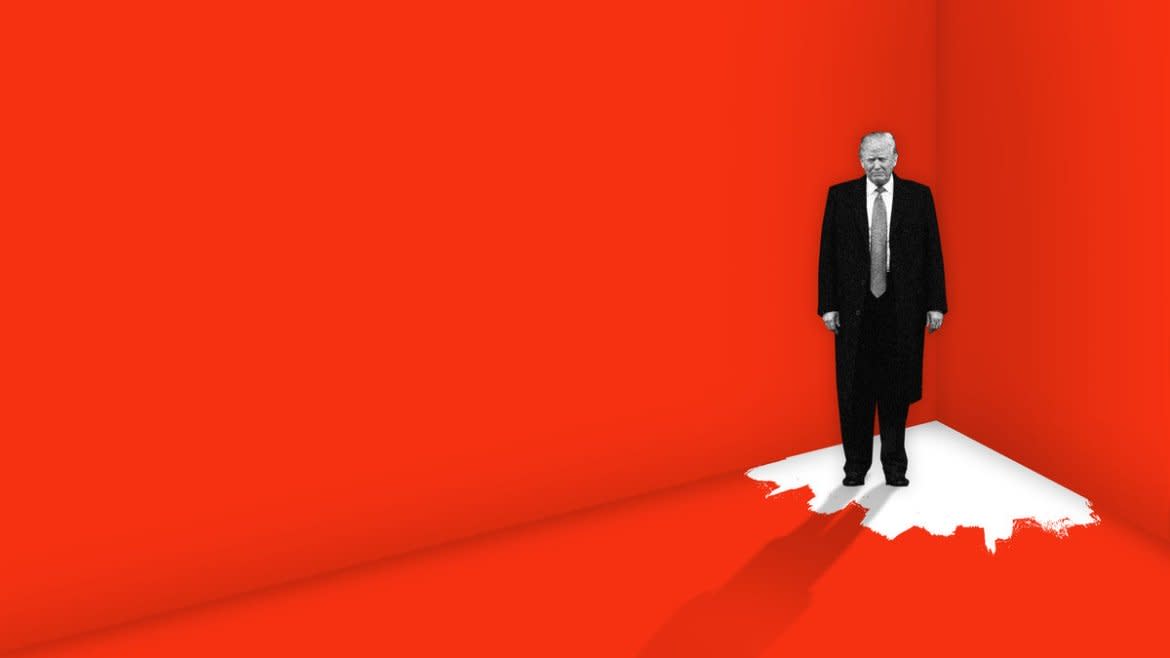Barr Tried to Get Trump Off the Hook. Instead He Painted the Boss Into a Corner.

Attorney General William Barr put out word this week that he’d refused Donald Trump’s request to hold a news conference and declare that the president broke no laws during his “perfect” call with Ukrainian President Volodymyr Zelensky. That followed stories reporting that Barr was “surprised and angry” that Trump had repeatedly invoked Barr’s name during that call.
But it was Barr who was at the very center of an audacious scheme to prevent an investigation of the president’s misconduct—a scheme that failed, and ended up setting the stage for Trump’s impeachment.
Barr became Trump’s favorite Cabinet member in March of this year when he held back release of the Mueller Report’s damaging findings while mistating them in a deceitful letter to Congress. Possibly overconfident following the success of that disinformation effort, Barr’s DOJ set out to prevent the whistleblower’s grave allegations against the president regarding Ukraine from even coming to light, let alone being investigated.
It was the DOJ that instructed acting Director of National Intelligence Joseph Maguire to violate his express statutory obligation to turn over the whistleblower’s complaint to Congress. The DOJ went so far as to create a widely mocked opinion from the previously respected Office of Legal Counsel purporting to justify this audacious violation of the law.
As later came to light, the DOJ’s Criminal Division claimed that it had exclusive jurisdiction to investigate the merits of the whistleblower’s claim. In a DOJ that followed normal-course ethical and law enforcement standards, the attorney general (who, rightly or wrongly, had been directly implicated in potential misconduct by the president) would have recused himself and the deputy attorney general would have appointed a special counsel, as occurred in the Russia investigation.
Neither of those steps were taken here, however. Rather, the DOJ’s Criminal Division conducted a review apparently consisting of some lawyers reading the summary of the Zelensky call and declaring that it did not seem to them that it violated campaign finance laws. The criminal division then apparently closed its file, without conducting any factual investigation into what turned out to be a wide-ranging criminal scheme involving numerous high-level government officials, including the president.
That cover-up scheme only came to light because the intelligence community’s inspector general, who had found that the whistleblower complaint met a statutory “urgent concern” standard, so informed Congress.
In retrospect, what happened next was all but inevitable. House Intelligence Committee Chair Adam Schiff made the scheme to hide the complaint public, ultimately pressuring the White House to cough up the complaint, and then the summary of Trump’s call with the Ukrainian leader. Once those cats were out of the bag, Schiff had all he required to merit commencing the investigation that has consumed Washington.
The great irony is that if Barr and his DOJ had even pretended to follow procedure here, with the AG recusing himself while a special counsel investigated the whisteblower’s complaint, they might have succeeded in bottling the matter up. Instead, Barr himself opened the door for—and all but necessitated—Congress’ investigation.
In the meantime, Barr’s focus reportedly remains on his own pet conspiracy theory: proving that the DOJ he now leads joined the CIA and other “deep state” actors in ginning up the investigation of Russia’s interference in the 2016 election in support to the Trump campaign in order to harm Donald Trump. In the upcoming days, we are told to expect the release of a DOJ inspector general’s report addressing purported Foreign Intelligence Surveillance Act abuses. But that is only an appetizer for the expected fruits of the ongoing investigation of purportedly criminal conduct by the dedicated law enforcement officers and public servants who investigated Russian interference in our democracy that has been a focus of Barr’s work for months. The attorney general (sometimes assisted by calls from Trump himself) has gone so far as to personally accompany prosecutor John Durham on visits to pressure sometimes dismayed foreign leaders for dirt on their own intelligence agencies, and on the DOJ itself.
Barr and his supporters insist that the attorney general’s own investigation of the investigation is wholly legitimate and aboveboard, and should not be confused with the “drug deal”—as then-National Security Adviser John Bolton called it — that Rudy (and Trump) spent many months attempting to engineer in the Ukraine; hence Barr’s stated “surprise” and “anger” that Trump mentioned him during the Zelensky call. But distinguishing between these closely related—and equally baseless—conspiracy theories, as those supporting Barr seek to do, misses the point entirely.
From the outset of his current tenure as attorney general, Barr has taken the lead in perverting the nation’s premier law enforcement agency into a mechanism for hiding, and disseminating misinformation about, evidence of presidential misconduct, even as he—much more effectively than Rudy Giuliani—has sought to construct a wholly false account of the foreign interference that infected the 2016 election.
In the upcoming months, we can expect that Barr will again seek to run interference for Trump, even as he fights a rearguard battle to distance himself from the seamiest elements of Trump’s abuses of power. Barr’s attempt to bottle up the evidence of Trump’s Ukraine scheme, however, was an utter failure. With appropriate vigilance, Barr’s future efforts to misuse the nation’s law enforcement powers and institutions will fail as well.
Get our top stories in your inbox every day. Sign up now!
Daily Beast Membership: Beast Inside goes deeper on the stories that matter to you. Learn more.

